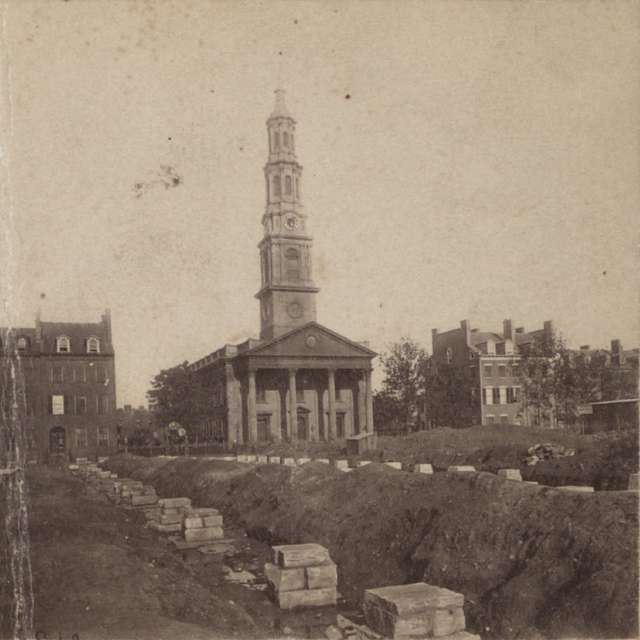Saint John’s Park
What if I told you that the Holland Tunnel exit plaza used to be the most exclusive nieghborhood in New York City?
The land on which the square sits was originally part of Lispernard Meadows a "swampy wetland". In 1700, the land was leased to Trinity Church, which later secured full ownership through a 212-acre land grant from Queen Anne.
Photo: NYPL Digital Archives
Trinity held it as farmland until it began development in 1800.
Trinity held it as farmland until it began development in 1800.
St. John's Chapel and St. John's Park. - Photo: LOC
Trinity Church envisioned an exclusive residential square inspired by London’s West End, featuring elegant Georgian, Federal, and Greek Revival townhouses around a private park. To entice buyers, Trinity Church commissioned the construction of St. John's Chapel, designed by John McComb who also designed City Hall, on the Varick Street side of the square.
Photo: LOC
Photo: NYPL Digital Archive
Residents were given exclusive access to the park through private keys, and the grounds were beautifully landscaped with gravel paths, flowerbeds, and a variety of trees. (Remind you of Gramercy Park perhaps...) The park also hosted church events and in winter, trustees would flood the grounds, transforming the park into a large ice-skating rink.
The sales had the covenant that if the owners failed to properly keep up the square it would be given to the city for public use.
Photo: NYPL Digital Collection
Photo: NYPL Digital Collection
By 1827, St. John’s Park had gained a reputation for its ornate elegance and had become one of the city's most fashionable enclaves. It attracted prominent residents from New York’s elite families, including the Hamiltons, Schuylers, Delafields, and Tappans.
Photo: NYPL Digital Archives
The decline of St. John's Park began in the late 1840s and early 1850s as affluent residents gradually migrated uptown. In 1867, Trinity Church sold the square to the Vanderbilt-owned Hudson River Railroad for $1 million.
St. Johns Freight Terminal - Photo: NYPL Digital Archives
Photo: NYPL Digital Archives
The elegant townhouses were demolished, and construction of the massive freight terminal "St. John's Park Freight Depot" began when 200 trees were cut down in the square. This is where Vanderbilt’s West Side Line, or High Line terminated.
The Commodore on the top frieze of the St. John's Freight Terminal. - Photo: NYPL Digital Archives
An interesting modern fun fact, is that the bronze sculpture of Commodore Vanderbilt that famously stands in front of Grand Central first stood atop the St. John's Freight Depot!
Photo: NYPL Digital Archives
Photo: NYPL Digital Archives
In 1892, Trinity Church announced plans to demolish St. John’s Chapel. This decision sparked fierce opposition from both the remaining congregants and outraged citizens who cherished the chapel’s architectural beauty. What followed was a two-decade-long battle between preservationists and those seeking its removal. It was eventually razed in 1918 for the widening of Varick Street.
St. John's Park today. - Photo: NYPL Digital Archives
Today, the Holland Tunnel entrance occupies much of the land where the park once stood.
The AIA Guide to New York City perhaps best summarized the loss. Speaking of the concrete-covered, traffic jammed area still called St. John’s Park, it said:
“…try to superimpose this image: gents in top hats and elegant women in long skirts strolling in a gracefully quiet park lined with staid houses, the chapel bells tolling in the evening. All gone. Our ancestors preserved many a New York treasure, but blew it here.”














